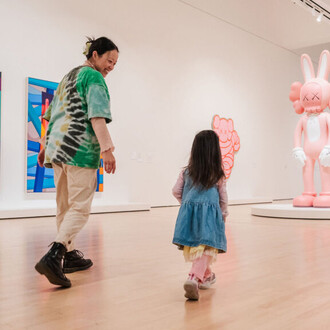Gallery Wendi Norris presents Remedios Varo: Encuentros, the Spanish artist’s second solo gallery exhibition since her death in 1963. With approximately twelve works on display, Remedios Varo: Encuentros explores Varo’s engagement with the unexpected. A decade after organizing the artist’s first solo gallery exhibition (Indelible Fables, 2012), Gallery Wendi Norris is thrilled to deepen its commitment to the work of Remedios Varo, a vitally important modernist and pioneer of a feminist Surrealism.
“This exhibition presents a rare and extraordinary opportunity to view powerful and awe-inspiring works by Remedios Varo, an imaginative artist whose mastery puts her in the ranks of the greatest painters of the 20th century,” states Wendi Norris, Varo’s gallerist and market expert.
The exhibition takes its name from one of Varo’s signature paintings, Encuentro (1959). In this composition, a woman in a watery blue dress sits at a table and opens a box from which her own face stares back at her. Varo’s visual imagination is replete with such uncanny encounters: chance meetings between two beings, confrontations with the self, entanglements with the cosmos, brushes with the unknown. In each piece in the exhibition, the natural laws of the universe are suspended.
Remedios Varo: Encuentros features paintings from throughout the artist’s career, including her last painting Naturaleza muerta resucitando (1963). In this wry take on the still life tradition, the objects are anything but still. Varo creates a dynamic vegetal solar system in which levitated fruits orbit a lighted candle, leaving trails of cosmic dust in their wake. Also on view is the haunting Ruptura (1955), a painting with the air of mystery for which Varo is famous. Rarely exhibited works on paper, like La torre (1947) and Apártalos que voy de paso (1959), offer viewers opportunities to experience other facets of the artist’s technical mastery and fantastical vision.
Remedios Varo is achieving widespread institutional recognition. The Museum of Modern Art (New York), the Detroit Institute of Arts, and the Toledo Museum of Art have all recently acquired Varo artworks from Gallery Wendi Norris. Her work was featured in the 59th Venice Biennale, The Milk of Dreams, as well as in the recent exhibitions Surrealism and Magic: Enchanted Modernity at the Peggy Guggenheim Collection (Venice) and the Museum Barberini (Potsdam), and Surrealism Beyond Borders at the Metropolitan Museum of Art (New York) and Tate Modern (London). It is currently on view in Third Eye: The Costantini Collection in Malba at Fundación Malba (Buenos Aires). Varo will be the subject of the forthcoming exhibition at the Art Institute of Chicago, Remedios Varo: Science Fictions, from July 29 to November 27, 2023, the artist’s first solo museum exhibition in the U.S. in 23 years.
Remedios Varo was born in 1908 in Girona, Spain and passed away at age 55 in Mexico City, Mexico in 1963. Raised by a Catholic mother and an agnostic engineer father, these two forces—the spiritual and scientific—greatly influenced Varo’s artistic career. A Spanish artist who played an integral role in the Mexico City-based Surrealist movement, Varo is known for her enigmatic paintings which unite scientific technical precision with esoteric and feminist subject matter.
After graduating from the Royal Academy of Fine Arts of San Fernando in Madrid, Varo moved to Barcelona in the mid-1930s and joined the Surrealist avant-garde art group Logicophobista. After the outbreak of the Spanish Civil War in 1936, she fled for Paris with Surrealist poet Benjamin Péret. In Paris, Varo became deeply involved with the Paris-based Surrealists, and her work was exhibited in the ground-breaking exhibition, Fantastic Art, Dada, Surrealism at the Museum of Modern Art, New York (1936), as well as multiple early Surrealist exhibitions around the globe: Exposition Internationale de Surréalisme (Tokyo, 1936), Surrealist Objects & Poems (London, 1937), Exposition Internationale de Surréalisme (Paris, 1938), Exposición Internacional del Surrealismo (Mexico City, 1940), to name a few.
With the outbreak of the Second World War, Varo fled Nazi-occupied France for Mexico City, where she connected with other exiled artists such as Alice Rahon, Wolfgang Paalen, Gordon Onslow Ford, and Leonora Carrington, who became Varo’s closest friend and colleague. During her early years in Mexico City, Varo honed her distinctive painting style while working various odd jobs, most notably creating illustrations for the pharmaceutical firm, Casa Bayer, between 1942-1949. Beginning in the mid-1950s, Varo experienced a domestic stability that enabled her to devote the rest of her life to painting. During these years, she produced a body of work that is typified by its female and androgynous figures (often disguised portraits of Varo herself), mystical narrative content, and a quality of ambiguity, mystery, and dark humor. In this last decade of her career, she developed a unique and virtuosic painting style which paired detailed preparatory drawings and meticulous rendering of her primary subjects in the tradition of early Renaissance masters, with Surrealist-derived automatic techniques like decalcomania. In 1956, Varo had her first major solo exhibition in Mexico City and it catapulted her to the forefront of the art scene. She continued to exhibit widely thereafter before her premature death in 1963.
Varo created approximately 384 works of art, over half of them drawings, which are now globally dispersed. Walter Gruen donated 38 significant artworks to the Museo de Arte Moderno in Mexico City. Gallery Wendi Norris has worked with Varo’s art since 2004 and has been the only gallery to present a solo exhibition of the artist, Indelible Fables (2012), since she passed away.
















